There are some journeys that stay with you long after you’ve returned — and the Kuari Pass Trek through the Garhwal Himalayas is one of those rare experiences. It’s more than just walking across snow-covered trails or conquering a high-altitude pass; it’s about waking up to golden Himalayan sunrises, pushing past limits, and rediscovering your bond with nature. From the spiritual calm of Rishikesh to the thrill of reaching the Kuari Pass summit at 12,500 ft, every day on this trekking adventure in Uttarakhand felt like a new story waiting to unfold. This is my journey — a blend of adventure, gratitude, and the raw, untamed magic of the Himalayas.
Day 1 – Reaching Rishikesh: The Gateway to Devbhoomi
My Kuari Pass trek began with an early morning flight to Delhi, followed by a long bus ride to Rishikesh, where the plains slowly rose into the hills and the holy Ganga River flowed beside us. Having visited a few times before, I checked into my go-to stay — Live Free Hostel, perfectly located near my trek pickup point.
By evening, I was drawn once again to the Ganga Aarti at Triveni Ghat — a mesmerizing ritual where priests in saffron robes swing giant lamps in harmony, chants fill the air, and thousands of diyas drift along the river, glowing like stars. It’s one of the most divine things to do in Rishikesh, and every time feels new.
Later, my college friend and I wandered through the lively streets and ended our night at the Beatles Café, soaking in the moonlit views of the Ganges. With fairy lights, soft music, and the river whispering below, it was the perfect prelude to the adventure ahead. I packed my rucksack and slept early — tomorrow, the Garhwal Himalayas awaited.
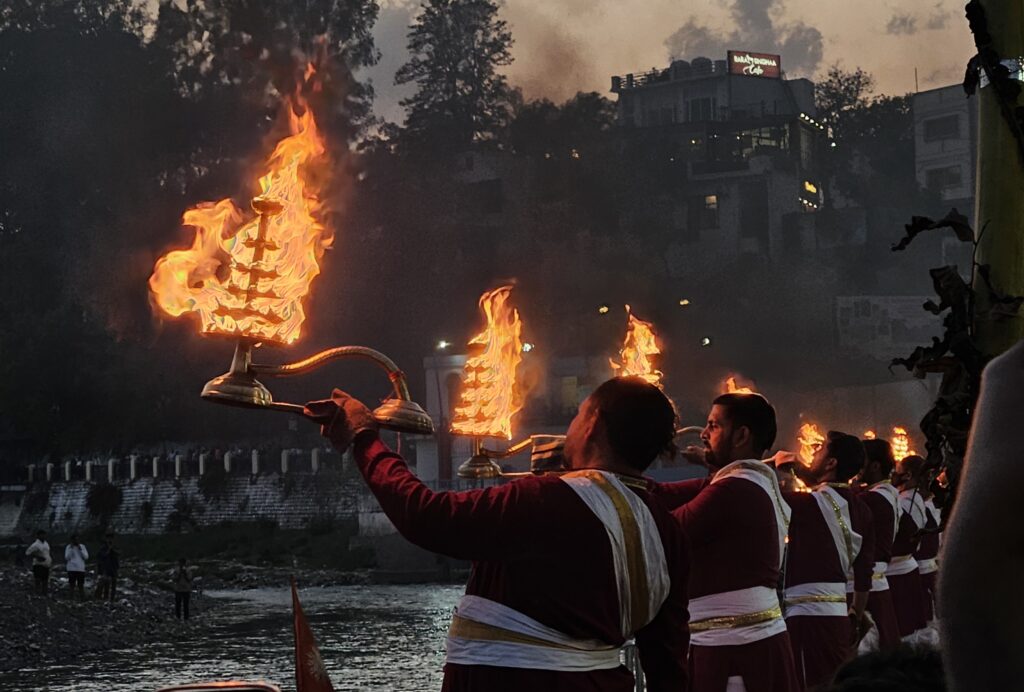
Day 2 – Driving to Karchi
The next morning marked the real beginning of my Kuari Pass trek adventure, with a long, winding drive toward Karchi village — a quiet settlement in Uttarakhand that serves as the base camp for Kuari Pass, Pangarchulla Peak, and the Valley of Flowers treks. The road to Karchi was not just a drive; it was an initiation into the rhythm of the Himalayas.

Along the way, we crossed Devprayag, one of the five sacred Prayags of Uttarakhand, where the Bhagirathi and Alaknanda rivers merge to form the Ganga. Watching these two powerful rivers—one emerald green, the other muddy brown—come together was a spiritual experience in itself. It felt like witnessing the birth of the Ganges, the lifeline of India.
Further along the route stood the Dhari Devi Temple, perched dramatically on a rock island in the middle of the Alaknanda River. Revered as the protector goddess of Uttarakhand, she’s deeply tied to local legends of divine intervention during floods and earthquakes. My trekmates and I wanted to stop and visit, but time was short—so we decided to pay a visit on our return journey.
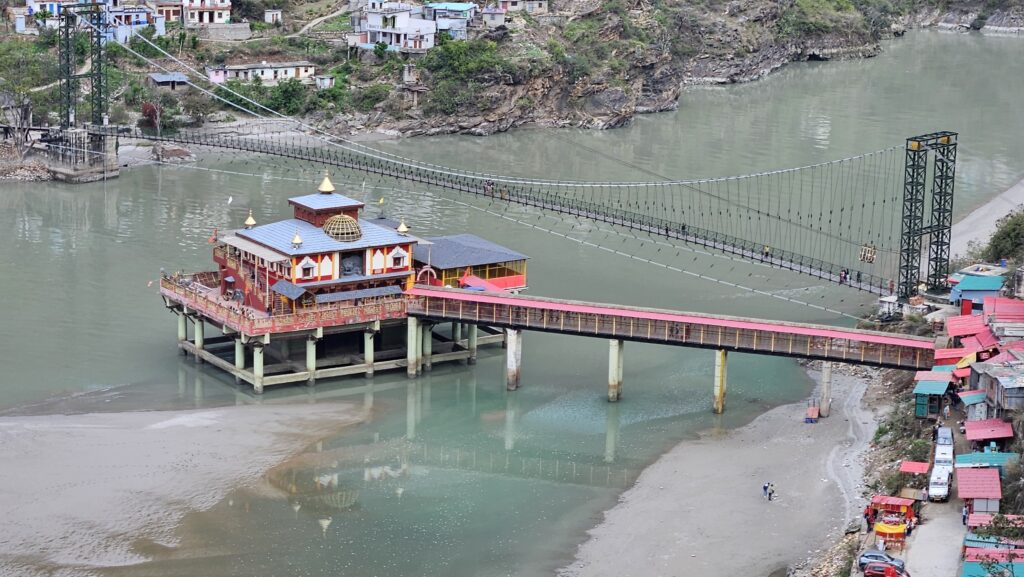
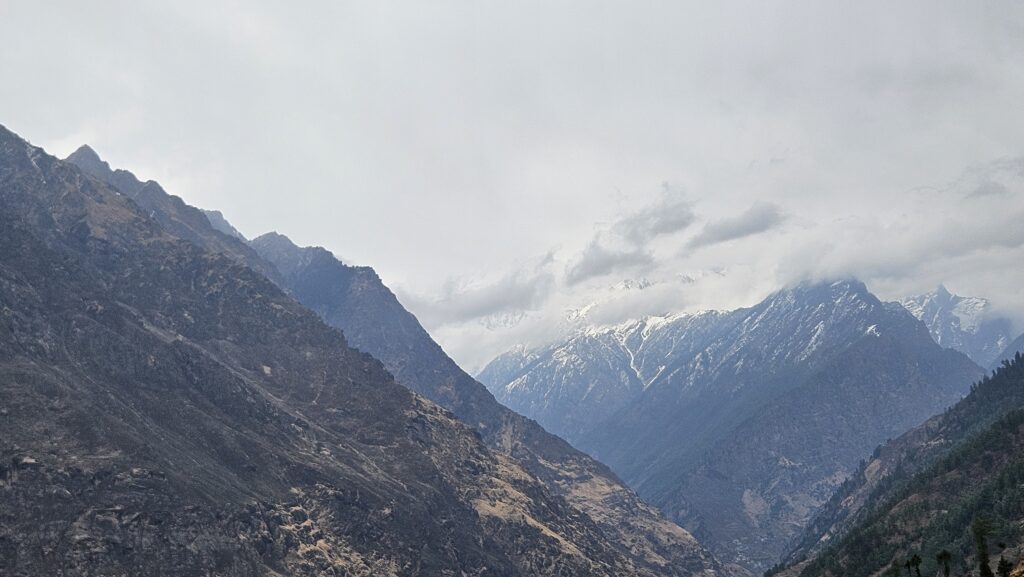
As we gained altitude, the landscape of Garhwal transformed before our eyes. The roads grew steeper and narrower, and the valleys deeper. Every turn revealed something more majestic—rolling hills giving way to snow-capped Himalayan peaks, with clouds weaving dreamlike patterns through the ridges. The fatigue of the 11-hour drive melted away in the face of such surreal beauty.
By evening, we reached Karchi base camp, where Indiahikes had set up our stay. Our group of 25 trekkers, led by one trek leader and three mountain guides, was welcomed with warmth and endless cups of tea. After the initial health check-ups and document formalities—a signature Indiahikes ritual to ensure safety—we gathered for an ice-breaker session that turned strangers into teammates.
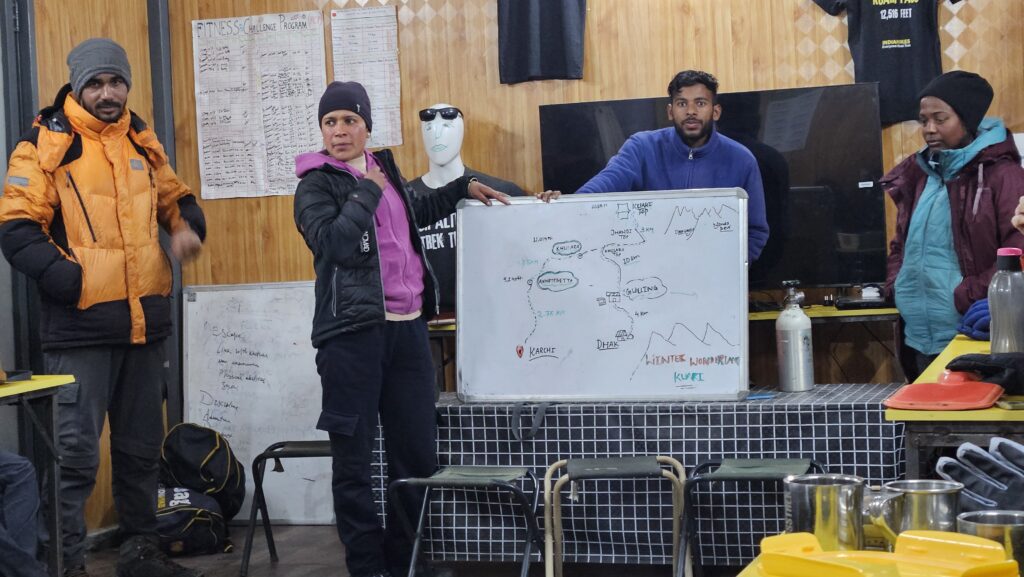
Later that night, under the cloudy Himalayan sky, I packed my gear, charged my camera for the last time, and slipped into bed early. Tomorrow, the real trek to Kuari Pass would begin—and I couldn’t wait to step into the wilderness.
Day 3 – Karchi to Akhrotghetta
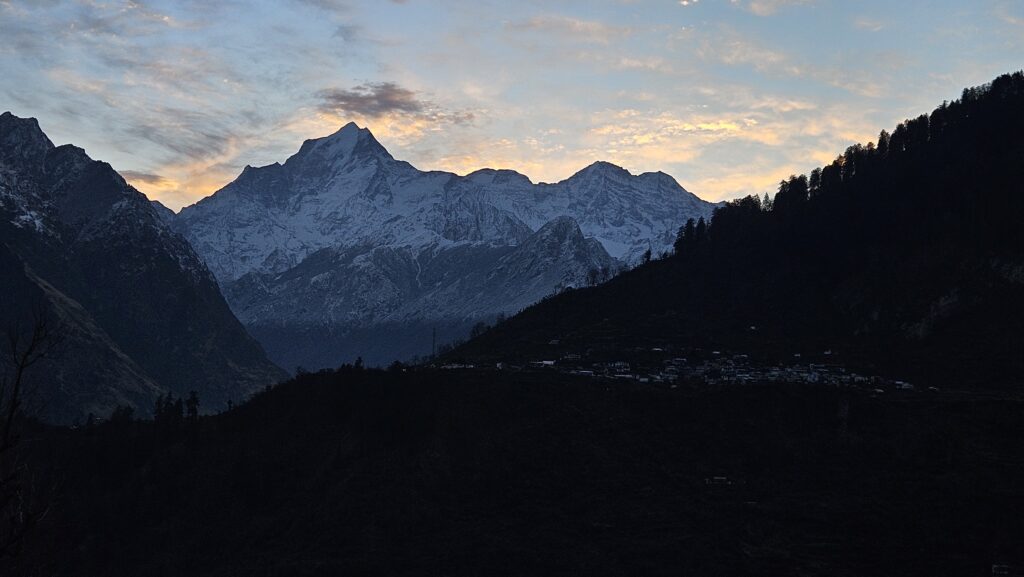
The morning at Karchi felt like waking into a dream—right before us stood the mighty Mt. Dronagiri, tall and imposing, stretching from its very base to the sky, a sight so rare and overwhelming that words barely do justice. Overnight snowfall had dusted the upper ridges in fresh white, and knowing we would soon be walking amidst that snow filled me with restless excitement. After a quick breakfast of hot idlis, eggs, and bananas, I geared up, rucksack strapped firmly, determined to carry my own load—because to me, trekking feels incomplete without the challenge of walking with everything you need on your back.
Our team gathered for a warm-up session, a simple yet essential ritual before stepping into the wild. Soon enough, we were off, heading towards Akhrotghetta, just 3 kilometers away. The initial trail was easy, winding past village houses and farmland, but soon gave way to oak-laden forests where the world turned quieter and more serene. With the day’s trail being short, we had the luxury of walking slowly, soaking in the fresh mountain air, adjusting our pace, and finding a rhythm with our backpacks.
Halfway through, we emerged into a clearing, and there stood Dronagiri again, now veiled in drifting clouds. Our guides asked us to sit quietly, close our eyes, and simply be. The forest responded: birdsong grew sharper, the stream’s gushing louder, leaves rustled like whispers of the earth. It was a moment of stillness, and when one of our trek mates began chanting, the silence turned meditative, elevating the experience into something deeply spiritual.


By noon we arrived at Akhrotghetta, named after the grand walnut tree shading the campsite. The staff welcomed us with lemonade, and after settling into our tents and stretching out our tired muscles, we layered up against the quickly dropping temperature. The afternoon unfolded lazily—lunch, exploring the surroundings, sharing stories, and bonding inside the dining tent. But as evening fell, the clouds parted, and what followed felt like pure magic: the mighty Dronagiri bathed in alpine glow, its snowy face turning golden before fading into twilight. Night brought with it a sky studded with countless stars. I couldn’t resist pulling out my camera and tripod, spending hours capturing the heavens above. It was the perfect end to a day that had already felt surreal.
Day 4 – Akhrotghetta to Khullara
The sun rose gently over Akhrotghetta, casting a warm glow on the walnut tree that watched over our camp. After a quick breakfast and some stretching, we began our hike towards Khullara, our next campsite. The trail was only about 3 kilometers, but with a steady climb from 9,264 ft to 11,014 ft, we knew it wasn’t going to be as easy as the distance suggested.
As we gained elevation, the oak forests thinned out and gave way to conifers, and soon the canopy opened up entirely. With each clearing, the panorama became grander—Dronagiri stood constant as our anchor, but now the surrounding peaks began revealing themselves too, painting a vast 180-degree sweep of the Himalayas. At one point, we even caught our first distant glimpse of the legendary Mt. Nanda Devi. Our guides asked us to pause here, not just to rest but to listen. They shared local tales and myths about these peaks—stories they had grown up with, ones that gave these mountains life and spirit far beyond their staggering size.
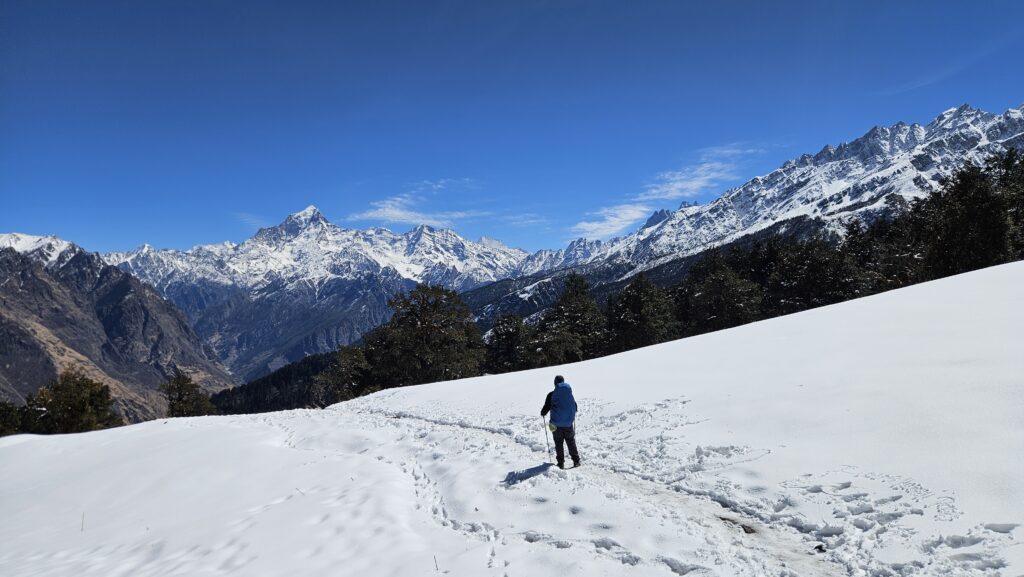

The higher we climbed, the thicker the snow under our boots. Hydration became a quiet mantra—steady sips of water to help our bodies adapt to the altitude. And yet, every time fatigue crept in, all it took was a glance around to forget the burn in our legs. The Himalayas have a way of humbling your exhaustion.
When we finally reached Khullara, it felt like stepping into another world. The campsite was unlike anything I had ever seen—each tent nestled within waist-high walls of snow, designed almost like igloos without roofs, cleverly trapping warmth and keeping the interiors surprisingly cozy. From here, the treeline had all but disappeared, leaving us with uninterrupted views of the great Himalayan sentinels. Along with Dronagiri, we now had clear views of the Haathi-Ghoda range, Mt. Neelkanth, and even Mt. Kamet—a constant reminder of how small we were in this grand amphitheater of nature.


Since we reached early, the afternoon was ours to relax. After layering up against the biting winds, we tucked into a hearty lunch and spent hours simply chatting, bonding, and gazing at the mountains, trying to etch the views into memory. But as dusk settled in, a certain tension filled the air. Tomorrow was our big day—the day we would attempt the Kuari Pass itself. Word had spread that the group attempting the pass today had turned back due to heavy snowfall. That news weighed on all of us. Inside the dining tent, our trek leader and guides patiently walked us through the plan, the challenges we might face, and the mindset we needed to carry.
With nerves, anticipation, and a silent hope that the weather would favor us, we crawled into our tents early. Tomorrow was not just another trek day—it was the day.
Day 5 – Conquering Kuari Pass!
Daybreak came with a nervous hush. The sky looked split—half clear, half cloudy—and unfortunately, the cloud cover seemed to be sitting right where we were headed: the summit side. The uncertainty added to the thrill. Along with our trek leader
and guides, a technical lead joined us that day—his role crucial, as yesterday’s snowstorm might have left fresh ice or tricky patches along the trail. Knowing he was with us gave a sense of safety, even as the looming clouds made us wary.
We left behind most of our gear at Khullara, carrying only the essentials in our day packs—water bottles, some snacks, and a power bank. It felt oddly liberating to be lighter, ready for the most important climb of the trek. Soon, the last traces of treeline disappeared behind us at Khullara Top, and the world transformed. The dense oak and conifers gave way to wide, sweeping meadows, blanketed in untouched snow. For a moment, it felt like walking straight into a tub of vanilla ice cream, each step sinking softly into the white expanse.

The climb from here was steady and relentless. At over 11,500 feet, the thinning air began to make itself felt—breaths grew shorter, hearts pounded quicker, and yet, the excitement drove us on. After a few hours, we reached Jandi Top, a crucial milestone just before the pass. This spot is known for its stunning views of Himalayan giants, but today, the mountains remained hidden, shrouded in stubborn clouds. Still, the lack of snowfall itself felt like a blessing—we could keep moving, and that was enough.
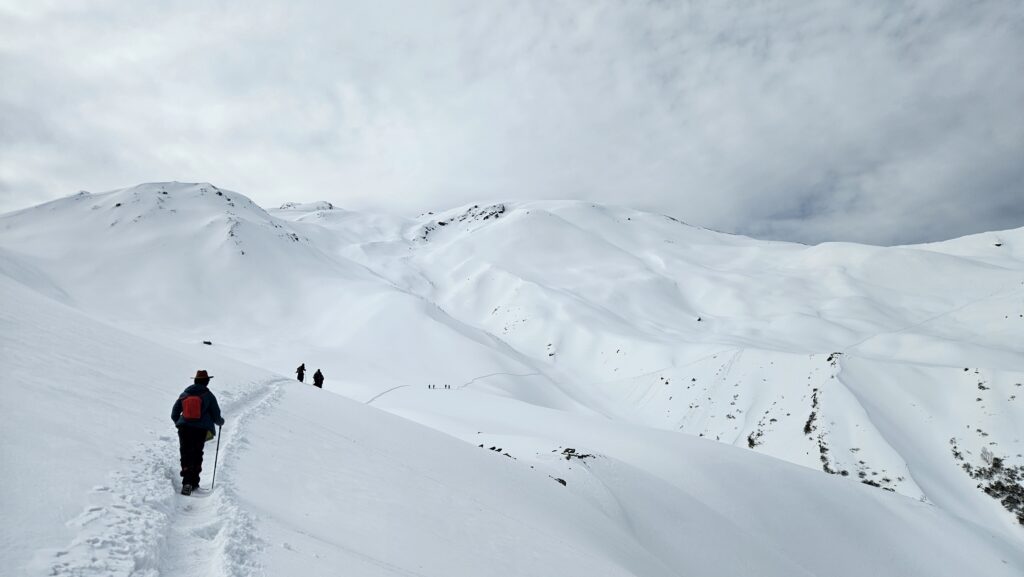
After a brief break, it was time for the final push: the 2 km ascent to Kuari Pass. This stretch was easily the most thrilling part of the trek. Much of the trail narrowed into a snow-laden ledge, forcing us to hug the slope and use our hands to balance. Yesterday’s storm had made the ledges even thinner, and every careful step felt like a small victory. It was nerve-wracking, yes, but the kind of adventure that sets your adrenaline alight.
And then, suddenly, the ledge ended, and the pass was right ahead. Something in me surged. Adrenaline, gratitude, sheer emotion—I couldn’t stop myself. I sprinted the final few meters, lungs burning, snow crunching beneath my boots, and dropped to my knees at the Kuari Pass top. My eyes welled up, my chest filled with gratitude. To be here, to have a body capable of carrying me, to stand where so many only dream of—it was overwhelming in the best possible way. Thats me rejoicing with one of my teammates who reached shortly after.


One by one, the rest of our team arrived. And against all odds, every single person made it to the top. For such a large group, a 100% success rate is rare, and it felt like nature itself was rewarding us. As if on cue, the clouds began to drift away, slowly unveiling the grandeur of a 360-degree Himalayan panorama. Names we had only heard—Dronagiri, Nanda Devi, Kamet, Chaukhamba—stood before us, giants in stone and snow. Time seemed to slow. Every direction was a postcard, every glance a memory for a lifetime.
After summiting Kuari Pass, we began our descent back to Khullara Top, where we paused for a quiet packed lunch against the same stunning peaks we’d admired from the summit. Once we packed up our tents at Khullara, we continued toward Gulling campsite. The way down was anything but dull—snow slides, playful snowball fights, and endless laughter kept the energy high. As we dropped below the snowline, forests and earthy trails replaced the alpine white. By evening, we reached Gulling and slipped into celebration mode. Huddled in the dining tent, we recounted every detail of the trek—from the climb to Kuari Top to the friendships forged on the trail. Dinner felt extra satisfying, followed by games and ghost stories that had everyone laughing and spooked in turns. Tired yet content, we called it a night, knowing this day would stay etched in memory for years to come.
Day 6 – From Gulling to Dhak: A Wholesome Goodbye
The morning at Gulling was nothing short of dreamy. After days of early starts and hurried mornings, today gifted us something rare—a slow, peaceful start. The sun was out, casting a soft golden glow across the campsite, the skies were clear, and the temperature felt just right, almost like nature’s way of bidding us farewell. Over steaming cups of chai, we lingered a little longer, soaking in the calmness that wrapped the valley.
And then, something magical happened. As we stood around, chatting and gazing at the horizon, the majestic Mt. Nanda Devi revealed itself. The peak, often shy and hidden behind curtains of clouds, peeked out in all its glory. Our guides told us how rare it was to see Nanda Devi from Gulling. That made the moment feel even more special, as if the mountain had chosen us to share this fleeting glimpse. The entire camp stood still, hushed and awestruck, watching the peak shimmer like a blessing.
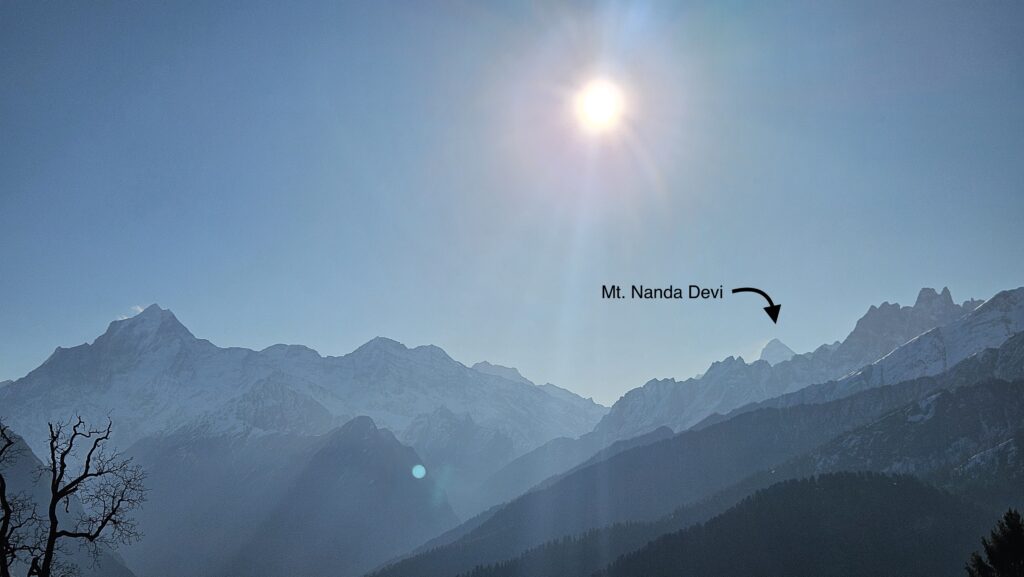
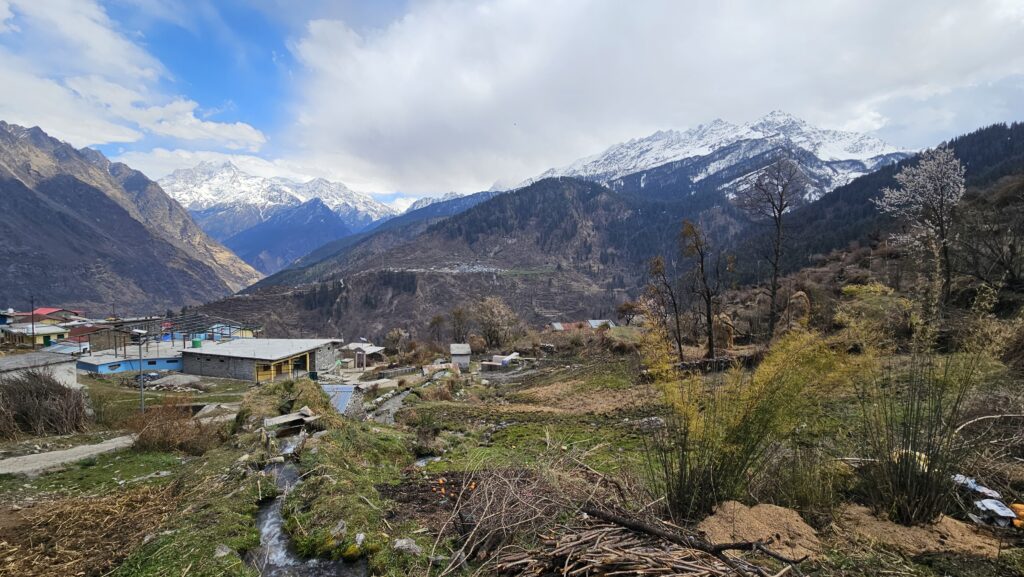
Not long after, it was time to descend. We packed up and began the trail towards Tugasi village, where our bus would take us to Dhak, our last stop. The descent was wholesome in every sense. We walked through meadows, passed fields that seemed to glow in the morning light, and strolled along narrow village roads where life carried on in its simple, beautiful rhythm. Children played in the courtyards, women carried baskets of fodder, and old men greeted us with warm smiles. Each interaction filled me with a sense of lightness—these little moments made the journey even richer.
Somewhere along the way, our guides asked us to pause at a clearing that opened up to a grand view of the mountains. Here, we were handed postcards and told to pen down our feelings—an exercise in reflection. At first, I wasn’t sure what to write. But as I looked at the towering peaks, words spilled out effortlessly. What I felt was an overwhelming gratitude—for the privilege of being here, for having a body strong enough to carry me, for being able to explore places my heart craves. I realized something simple yet profound: the life we treat as “ordinary” is someone else’s dream come true. Be grounded, be grateful. Strive for more, yes, but never forget to celebrate what you already hold.
Around me, emotions flowed differently—some trekkers wrote with joy, some cried quietly, some stayed detached. And that was the beauty of it. Nature doesn’t dictate how you connect with it; it simply offers you the space. Each of us found our own meaning in that silence.
By late afternoon, we reached Tugasi, walking the last leg of village roads while collecting bits of trash—one small way of giving back to the mountains that had given us so much. After a short bus ride, we arrived at Dhak, our homestay for the night. And oh, what a joy it was! After four nights of camping in freezing temperatures, stepping into a warm, cozy homestay felt almost unreal. A hot shower, clean clothes, and the comfort of a real bed—it was bliss.

That evening was reserved for reflection. As we gathered with coffee mugs and plates of hot snacks, our group of 25 trekkers opened up in ways we hadn’t before. We came from different cities, professions, and age groups, but here, our stories intersected. People shared what the trek meant to them, the lessons they were carrying back, the fears they overcame, and the little joys that made it special. Listening to everyone broadened my perspective—this journey wasn’t just about mountains and summits, it was about people too. The laughter, the tears, the camaraderie—it all came together in that final evening.
Before sleeping, we returned our rented gear, finished up the last of the formalities, and packed our bags for the long ride back to Rishikesh the next day. As I slipped under the blanket that night, I realized how full my heart felt. The mountains had given us their all, and we had lived every bit of it. Tomorrow we would leave, but tonight, I slept with the peace of someone who had found a piece of themselves in Devbhoomi’s grandeur.
Wrapping this long blog up, this amazing trek wouldn’t have been possible without Indiahikes. It is an organisation that, in my view is indeed doing something to leave this world a better place to live in and I highly recommend you guys to check them out and what they are about. They also have the detailed itinerary for this trek if you are interested in that – Kuari Pass Trek with Indiahikes
